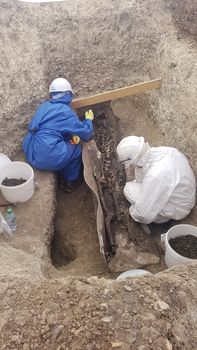HS2 Historic Environment Digital Archive
High Speed Two Ltd., 2023. https://doi.org/10.5284/1113008. How to cite using this DOI
- Introduction
- Overview
- Sites
- HS2 Collections:
- Metadata
- Usage Statistics
Data copyright © High Speed Two Ltd. unless otherwise stated
This work is licensed under a The Open Government Licence (OGL).
Primary contact
High Speed Two Ltd.
2 Snowhill
Queensway
Birmingham
B4 6GA
United Kingdom
Tel: 08081 434 434
Resource identifiers
- ADS Collection: 4060
- DOI:https://doi.org/10.5284/1113008
- How to cite using this DOI
Overview

The historic environment programme for HS2 works is being delivered by HS2's supply chain, employing specialist contractors to undertake the range of works required. This work includes evaluation, recording and investigation, post-excavation assessment, analysis, archiving and dissemination of the results and archiving. The creation of HS2's physical and digital archive is an integral part of the lasting legacy of the programme.
Headline Objective 03 of the HERDS is to develop and deliver a highly accessible archive and outstanding archival legacy that will be actively promoted.
The archive includes digital information generated during the entire programme of research into the historic environment from the environmental impact assessment stage, to site evaluation and detailed investigations into specific locations and landscapes. It also includes post excavation assessment and analysis of the discoveries made.
The physical element of the archive will be deposited in the appropriate accredited museum/archive repositories.
Effective links will be developed between the physical museum/repository held archive and the digital archive held by the ADS, via OASIS (Online Access to the Index of archaeological investigationS).
The objectives for the digital archive are:
- To preserve digital data in the long term so that the digital data remains accessible for use in the future.
- To ensure that appropriate selection criteria are used to enable each deposited archive to be an accurate, relevant and efficient record of the project, with data findable, accessible, interoperable and re-usable.
- To ensure that all digital data are accompanied by consistent, accurate and high-quality metadata that will facilitate re-use.
- To effectively link all relevant and appropriate historic environment digital data to the appropriate physical archive repository.
- To provide a valuable digital resource, that enables onward innovation and creativity for research, learning and engagement.





